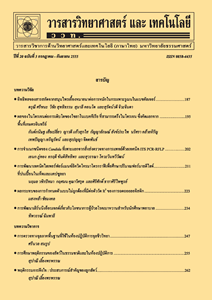Organic Carbon Sequestration in the Bottom Sediments of Hybrid Catfish Ponds
Main Article Content
Abstract
The objectives of this study were to assess the rate and potential of organic carbon sequestration in the bottom sediments of hybrid catfish (Clarias macrocephalus x C. gariepinus) ponds using organic carbon content, dry bulk density and sediment accumulation rate. Sediment samples were collected in 12 hybrid catfish ponds from 3 farms in Chang Ming subdistrict, Pannanikhom district, Sakon Nakhon province during January to February 2017. The results were the averages of pond age 3.50±0.52 years, sediment depth 19.88±4.04 cm, sediment accumulation rate 5.86±1.64 cm/year, dry bulk density of sediment 0.77±0.07 g/cm3, organic carbon content 1.51±0.45 % and organic carbon sequestration rate 699.22±370.91 g/m2/year. The potential of organic carbon sequestration in the sediments of 1,040 m2 (the average of hybrid catfish pond area) was 727.19 kg/year. Hybrid catfish pond can be a global carbon sequestration source by storing in the sediments.
Article Details
References
Department of Ecology State of Washington, 2013, Focus on Soil Carbon Sequestration, Publication Number 13-07-031, Available Source: https://fortress.wa.gov/ecy/publications/publications/1307031.pdf, December 15, 2017.
Downing, J.A., 2010, Emerging global role of small lakes and pond: Little things mean a lot, Limnetica 29: 9-24.
Taylor, S., Gilbert, P.J., Cooke, D.A., Deary, M.E. and Jeffries, M.J., 2019, High carbon burial rates by small ponds in the landscape, Front. Ecol. Environ. 17: 25-31.
Boyd, C.E., Wood, C.W., Chaney, P.L. and Queiroz, J.F. Queiroz, 2010, Role of aquaculture pond sediments in sequestra tion of annual global carbon emissions, Environ. Pollut. 158: 2537-2540.
Anikuttan, K.K., Adhikari, S. and Kavitha, M., 2016, Carbon sequestration capacity of sediments, algae, and zooplankton from fresh water aquaculture ponds, Environ. Monit. Assess. 188: 422.
Adhikari, S., Lal, R. and Sahu, B.C., 2012, Carbon sequestration in the bottom sediments of aquaculture ponds of Orissa, India, Ecol. Eng. 47: 198-202.
Fisheries Development Policy and Strategy Division, 2018, Fisheries Statistics of Thailand 2016, No. 12/2018, Department of Fisheries, Ministry of Agriculture and Cooperatives, Bangkok, 65 p. (in Thai)
Fisheries Development Policy and Strategy Division, 2019, Fisheries Statistics of Thailand 2017, No. 9/2019, Department of Fisheries, Ministry of Agriculture and Cooperatives, Bangkok, 87 p. (in Thai)
Boyd, C.E. and Tucker, C.S., 1992, Water Quality and Pond Soil Analyses for Aquaculture, Alabama Agricultural Experiment Station, Auburn University, Alabama, 183 p.
Boyd, C.E., 1995, Bottom Soil, Sediment and Pond Aquaculture, Chapman & Hall Book, New York, 348 p.
Xiaonan, D., Xiaoke, W., Lu, F. and Zhiyun, O., 2008, Primary evaluation of carbon sequestration potential of wetlands in China, Acta Ecol. Sin. 28: 463-469.
Adhikari, S., Lal, R. and Wang, H.P., 2014, Carbon sequestration in the soil of aquaculture ponds, crop land, and forest land in southern Ohio, USA, Environ. Monit. Assess. 186: 1569-1574.
Kunlapapuk, S., Wudtisin, I., Yoonpundh, R. and Sirisuay, S., 2019, Effect of different feed loading on sediment accumulation rate and carbon burial rate in the polyculture system of Nile tilapia (Oreochromis niloticus) and pacific white shrimp (Litopenaeus vannamei), J. Fish. Environ. 43: 30-42.
Wudisin, I., Saeiam, Y. and Kulabthong, S., 2015, Properties and accumulation rate of sediments in nile tilapia (Oreochromis niloticus) ponds and ponds with cages containing red tilapia (Oreochromis niloticus x mossambicus), Fish. Res. Bull. Kasetsart Univ. 39(1): 48-60.
Adhikari, S., Mahanty, D., Ikmail, S. and Sarkar, S., 2019, Carbon storage in sediments of freshwater fishponds of Orissa, Andhra Pradesh, and West Bengal, India, Aust. J. Environ. Toxicol. 5: 1026.


